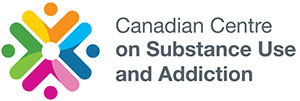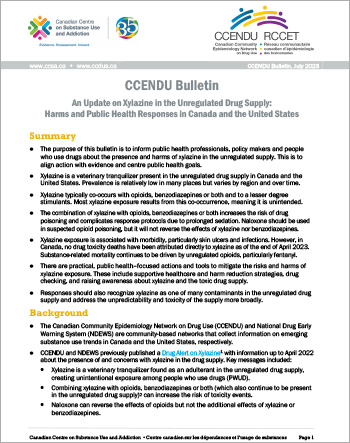CCENDU Bulletin: An Update on Stimulant Use and Related Harms in Canada and the United States (December 2022)
Xylazine (CCENDU Drug Alert) (December 2022)
Xylazine (CCENDU Drug Alert)
Summarizes the increased risk of accidental overdose due to xylazine in Canada’s unregulated drug supply. Xylazine is a non-opioid pain reliever developed as a sedative and muscle relaxant for animals. It is being found as an adulterant in other drugs. In combination with other sedatives like fentanyl, benzodiazepines or alcohol, xylazine can increase the risk of overdose and death.
Nitazenes (CCENDU Drug Alert) (March 2022)
Nitazenes (CCENDU Drug Alert)
This alert summarizes the increased risk of accidental overdose due to nitazene compounds being identified in Canada’s unregulated drug supply. Nitazene compounds are ultra-high potency, synthetic opioids, usually found unexpectedly in substances thought to be other opioids, such as fentanyl.
CCENDU Bulletin: Risks and Harms Associated with Nonmedical Benzodiazepines in the Unregulated Drug Supply in Canada (December 2021)
Changes Related to COVID-19 in the Illegal Drug Supply and Access to Services, and Resulting Health Harms (May 2020)
Adulterants, Contaminants and Co-occurring Substances in Drugs on the Illegal Market in Canada (April 2020)
Adulterants, Contaminants and Co-occurring Substances in Drugs on the Illegal Market in Canada
Drugs bought and sold on the illegal market are unregulated, unpredictable and often contaminated with substances in addition to, or instead of, those intended, which increases the probability of drug-related poisoning and other health threats. This bulletin provides a snapshot of drug contents on the illegal market in Canada using 2018–2019 data from drug seizures, drug checking services and a drug content monitoring study. It is accompanied by a technical report that explains the research methods used and provides more detailed findings.
Changes in Stimulant Use and Related Harms: Focus on Methamphetamine and Cocaine (April 2019)
Changes in Stimulant Use and Related Harms: Focus on Methamphetamine and Cocaine
In response to reports of increasing harms related to methamphetamine use in Canada, this bulletin summarizes recent changes in stimulant-related harms in Canadian communities. It includes reports from municipalities, provinces and territories describing notable trends in stimulant use, levels of concern and local responses.
Drug Trends and Related Harms at Canadian Music Festivals (August 2017)
Drug Trends and Related Harms at Canadian Music Festivals
This bulletin provides a snapshot of drug use trends, drug risks and lessons learned emerging from Canadian music festivals between May 1, 2017, and July 31, 2017. This information can be used to inform efforts to safeguard attendees at subsequent festivals.
Calling 911 in Drug Poisoning Situations (March 2017)
Calling 911 in Drug Poisoning Situations
This bulletin provides the first Canadian estimates on rates of calling 911 in drug poisoning situations. People trained to administer naloxone and who had used a naloxone kit to treat an overdose did not call 911 in 30% to 65% of cases. The bulletin recommends that anyone distributing naloxone to laypeople emphasize that calling 911 in drug poisoning incidents is critical.
Novel Synthetic Opioids in Counterfeit Pharmaceuticals and Other Illicit Street Drugs (June 2016)
The Availability of Take-Home Naloxone in Canada (March 2016)
The Availability of Take-Home Naloxone in Canada
This bulletin describes the availability of take-home naloxone programs in Canada and the steps required to make naloxone available without a prescription. It notes that access to naloxone, a drug used to temporarily reverse the effects of opioid overdose, is only one part of an overdose prevention strategy, which should also include overdose prevention education, training and services.
Deaths Involving Fentanyl in Canada, 2009–2014 (August 2015)
Deaths Involving Fentanyl in Canada, 2009–2014
This bulletin reports on the marked increase in the number of deaths involving fentanyl in Canada between 2009 and 2014, with data collected from 12 participating provinces and territories. During this period, deaths involving fentanyl increased significantly in Canada’s four largest provinces, ranging from almost doubling to an increase of over 20 times.
Fentanyl-related Overdoses (February 2015)
Fentanyl-related Overdoses
This alert is to advise that, as of February 6, 2015, there continues to be reports of fatal and non-fatal overdoses that are suspected or confirmed to involve non-pharmaceutical (illicit) fentanyl. Most overdoses appear to be in individuals who thought they were using heroin, oxycodone, cocaine or another substance, but have mistakenly taken fentanyl.
Drug-related Harms at Canadian Music Festivals (September 2014)
Drug-related Harms at Canadian Music Festivals
This bulletin addresses drug-related deaths and illnesses that occurred at Canadian music festivals during the summer of 2014. The bulletin issues a call for additional information and announces the assembly of a group of experts to develop recommendations for preventing, preparing for and responding to drug-related overdoses at large festivals.
Synthetic Cannabinoids (March 2014)
Synthetic Cannabinoids
This bulletin contains an overview of synthetic cannabinoids and their presence in Canada.
Increasing Availability of Counterfeit Oxycodone Tablets Containing Fentanyl (February 2014)
No Confirmed Reports of Desomorphine (“Krocodil”/“Crocodile”) in Canada (November 2013)
Illicit Fentanyl (July 2013)
Illicit Fentanyl
This alert notes that reports from Canada and the United States indicate that illicit fentanyl produced in clandestine laboratories, rather than diverted prescription-grade fentanyl, has been appearing for sale on the streets.
Misuse of Opioids in Canadian Communities (May 2013)
Bath Salts (June 2012)
Bath Salts
This alert provides information on a new and emerging synthetic amphetamine-type drug referred to as “bath salts.”

